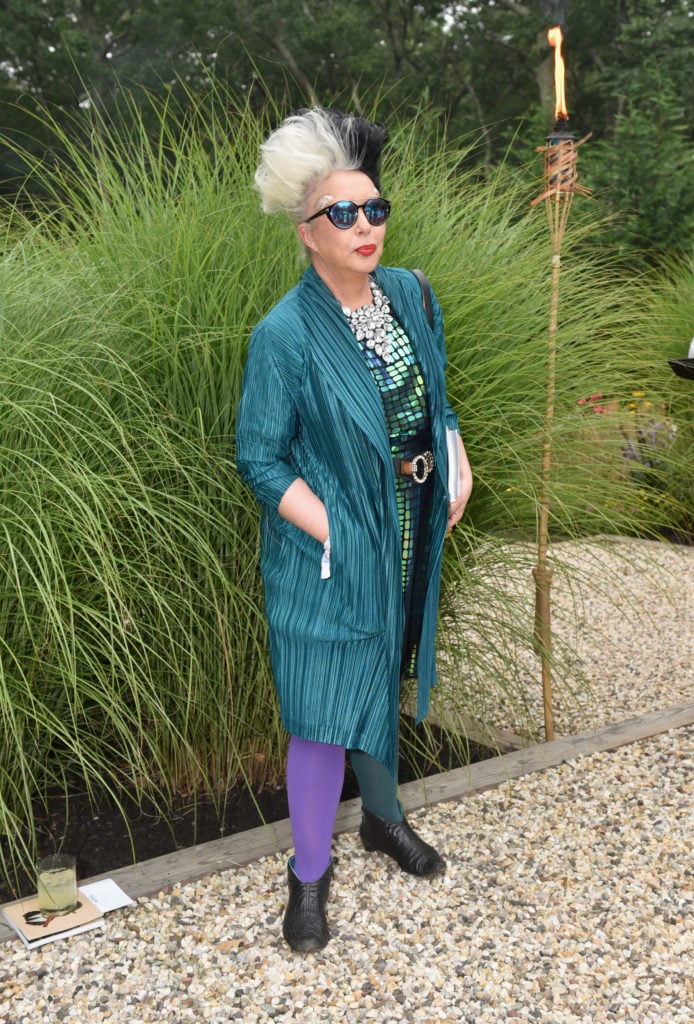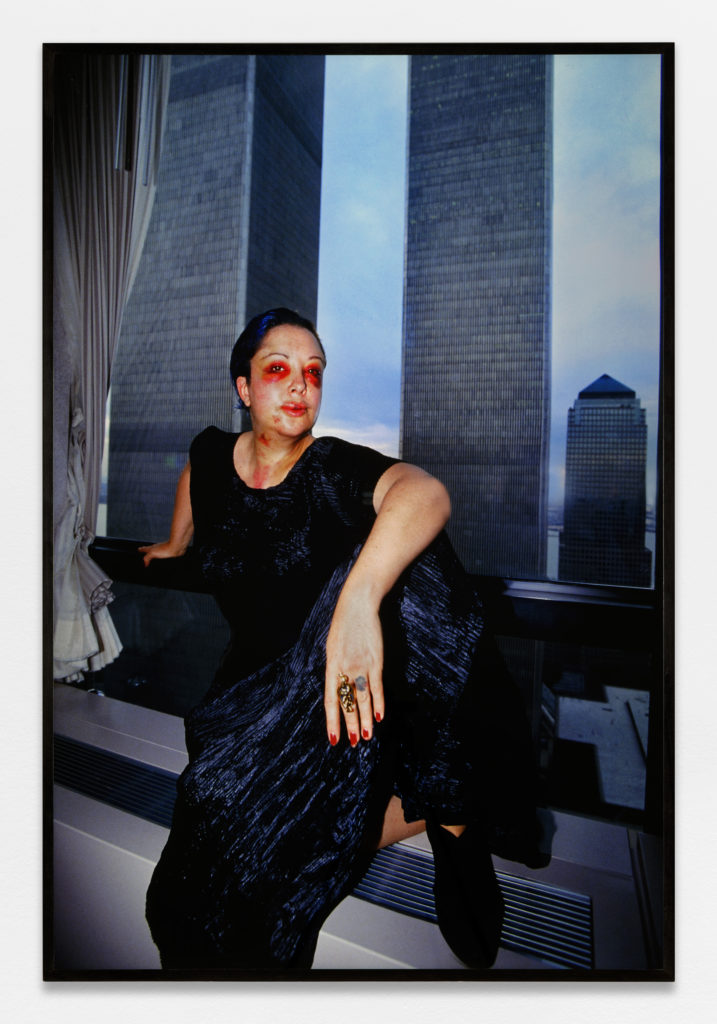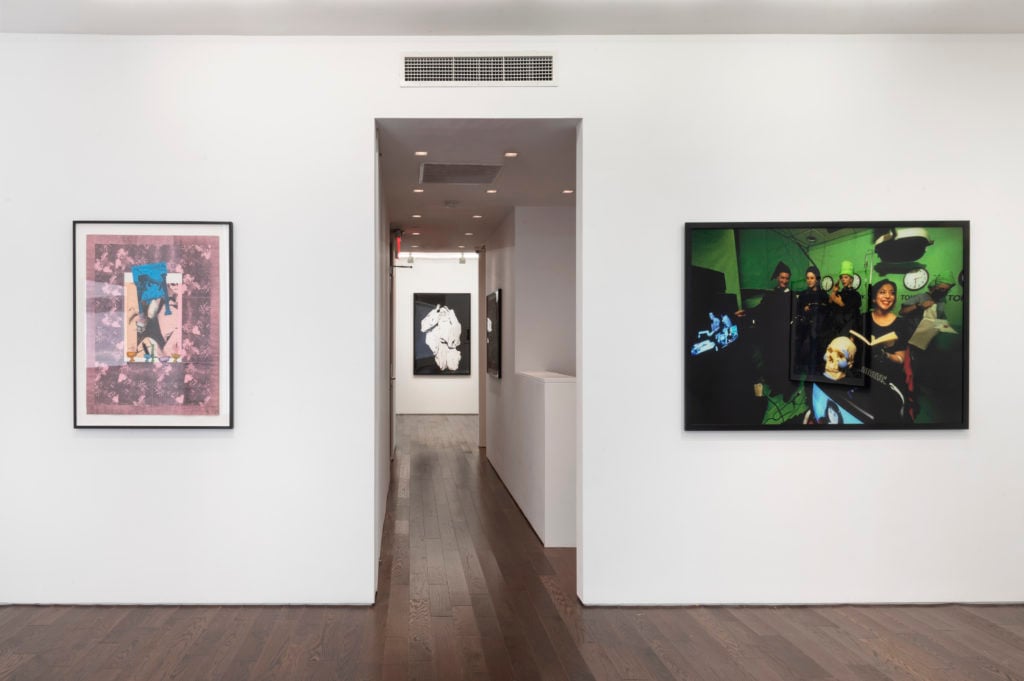On View
Provocateur Orlan Reflects on How She Went From Being Reviled for Her Body Art to Claiming Her Place in the Art World
The French artist's show at Ceysson & Bénétière is her first New York show since 1995.

The French artist's show at Ceysson & Bénétière is her first New York show since 1995.

Sarah Cascone

For her first New York solo show since 1995, French multimedia artist ORLAN is reminding viewers of what she’s best known for: The unusual plastic surgeries that transformed her face by adding unnatural growths at her temples. The nine procedures, carried out between 1990 and 1993, collectively make up the piece “The Reincarnation of Saint ORLAN.” Three giant photographs on view at Ceysson & Bénétière document the surgeries and their aftermath.
In one, ORLAN sits on the operating table, surgical directions scrawled across her face, smiling and reading aloud—thanks to anesthetics that ensured a complete lack of pain, she remained awake for each of her procedures.
The other images were shotpost-operation, her beautiful face swollen and discolored, red bruises blooming around her eyes. Taken at the window in ORLAN’s apartment in Lower Manhattan, the photos show the Twin Towers and the Woolworth building just behind her.
“I’m getting emotional when I look at it, because New York doesn’t have the same face,” ORLAN told artnet News, speaking at the gallery the day before the 18th anniversary of the 9/11 attacks that destroyed the World Trade Center. “I love New York,” she added.

ORLAN, Refiguration d ORLAN défiguration de New York (1993). Photo ©A. Mole, courtesy of Ceysson & Bénétière.
Though ORLAN’s facial modifications are often referred to as horns, the artist simply refers to them as “my bumps.” They were created using the same kind of implants used to enhance one’s cheekbones, just placed above the eyebrows.
The implants were inserted during a live performance broadcast to museum audiences—a challenge before the advent of webcams, requiring the use of a satellite link. (ORLAN’s other pioneering uses of technology have included photocopier collages, on view in the show, as well as early digital photography and photo manipulation in Photoshop. More recently, she has made a video game, an AI robot made in her likeness, and an augmented reality app.)
The artist’s decision to alter her face so dramatically was not particularly well received. “Some people wouldn’t talk to me anymore,” ORLAN recalled. But she had already renamed herself as a teenager—born Mireille Suzanne Francette Porte, ORLAN chose to style her new name in all caps, “because I do not want to return to the ranks, I do not want to be put back into the line.” Now, she wanted a new face to go along with it.

“ORLAN: SAINT ORLAN” at Ceysson & Bénétière. Photo courtesy of Ceysson & Bénétière.
“The face that you have is something you don’t chose,” ORLAN explained. “I wanted to attack Mother Nature.” Unlike the traditional motivations for plastic surgery, these operations weren’t an effort to make her look younger or more beautiful. Tired of the ways that societal beauty standards constrain women, ORLAN specifically set out to make herself less beautiful.
“All my work is against the stereotype,” she insisted.
The other half of the exhibition features 23 photographs of ORLAN’s 1979 performance Etude documentair: le Drapé-le Baroque. Over the course of three hours, men carried ORLAN in a procession at Venice’s Palazzo Grassi. Laid out in a box, clad in the billowing drapery of a Baroque saint, she moved in slow motion, shedding her garments to reveal a single breast, before crawling out of the building and disappearing to a waiting boat on the canal.

ORLAN, Vierge blanche sortant du noir (1978). Photo ©A. Mole, courtesy of Ceysson & Bénétière.
The piece, which visually recalls the almost sexual elation of Bernini’s Ecstasy of Saint Teresa, invites the viewer to think about women as complex beings, not judged by a strict Virgin/whore dichotomy. “These two stereotypes are difficult to escape when you are a woman,” ORLAN explained. “It’s about the importance of the and, and not or.”
ORLAN began making art “when I was a baby,” attending art school but dropping out because it “was too conventional from me.” She counts 1964, the date of her first documented work, ORLAN Gives Birth to Her Beloved Self—a photo in which the naked artist appears to have just delivered an androgynous mannequin—as her own date of birth (actually she was born in 1947).

ORLAN, Chevalet drappé dentelle et faux marbre (1978). Photo ©A. Mole, courtesy of Ceysson & Bénétière.
From the beginning, her body was ORLAN’s medium, whether that involved contorting it into unattractive poses for her “Body-Sculptures,” or dragging herself across the floor in famous public spaces to count how many body lengths they measured in the “MesuRAGES.”
“Working with my body was a political gesture,” said ORLAN. “It was an act for the woman I was/I am/I will be, and all women, to claim their freedom, which was denied to them.”
The current political climate, with the conservative threat to abortion rights in the US, has been difficult for her to witness. “In France, it is very difficult to be feminist without being dismissed. In 1960, it was really terrible for women. There was no contraception,” ORLAN recalled. “I really feel that my life has been useless because I have always worked for the place of women in art and society.”
“ORLAN: SAINT ORLAN” is on view at Ceysson & Bénétière, 956 Madison Ave 2nd Floor, New York, September 12–November 2, 2019.